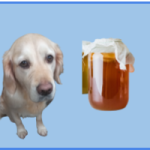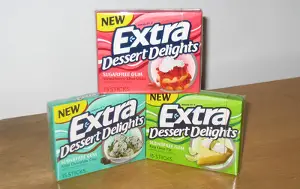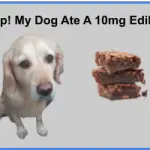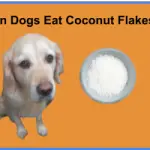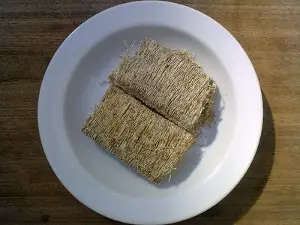
Shredded Wheat was introduced as a breakfast cereal in 1893 in Chicago.
However, these pillows of wheat had been made for a few years and one of the original ideas for them was to be used as croutons in soup.
Currently in the U.S. the biggest manufacturer of shredded wheat is the cereal company Post.
However, because of how successful it has been, other big cereal companies have created their own varieties.
And I will quickly talk about those in the next section.
But regardless of whether there is one variety of ten- should your dogs be eating these?
What varieties of Shredded Wheat are there?
The first way in which these wheat pillows vary is by size.
And there are two sizes.
The original size is a wheat biscuit which is about 5 inches long and three inches wide.
The newer size is a bite size or spoon size.
These pillows are much smaller and will fit on a desert spoon.
The second variation is by ingredients.
Original shredded wheat is 100% wheat- which was part of its claim to fame.
But in the last decade or so there has been an explosion in flavours.
One alternative that has been created is a biscuit which is part wheat and part bran.
But let’s face it, a cereal that is 100% wheat or 50% wheat and 50% bran isn’t going to get kids excited is it?
Which is why frosted mini wheats were created.
Spoon size pillows of 100% wheat but covered in a layer of frosted sugar.
Now that is more like it!
Frosted varieties also include strawberry and cinnamon roll flavours!
But a list of flavours just doesn’t cut it.
In the next section, I want to look at these ingredients in more detail and find out how dog friendly they are.
What are the ingredients in Shredded Wheat?
Wheat
Original Shredded Wheat is 100% whole grain wheat.
And many would say that you can’t get any more healthy than that.
And wheat has been traditionally seen as a very healthy food or grain.
Up until around a decade ago, wheat has been one of the main grains used in commercial dog food.
And for good reason. It is relatively cheap and wholesome.
The nutrition in whole wheat, per 100g, is as follows:
| Calories | 340 |
| Fat | 2.5 g |
| Carbohydrate | 72 g |
| Dietary Fiber | 11g |
| Protein | 13 g |
| Vitamins | B1, B3, B6 |
| Minerals | Copper, Phosphorous, Manganese |
Wheat contains quite a lot of calories- 100g contains 304.
In contrast 100g corn contains just 86.
Wheat is 72% carbohydrate, which I guess is where the calories are coming from.
However, of that 72%, a whopping 11% is dietary fiber which is a very high figure and is excellent in aiding your dog’s digestion system.
Wheat also has a lot of protein in it- 13% in fact.
Again, this is a lot of protein.
And protein plays a crucial role in helping to build muscle and to repair it.
Having lots of calories in it isn’t the only downside of wheat.
Another major one is that dogs can be intolerant of it.
The exact number of wheat or gluten intolerant dogs isn’t known as it is difficult enough to estimate how many people are allergic to wheat.
A conservative estimate is that around 7% of the global population could be intolerant of gluten.
But this is a very contentious issue as some scientists would say that the figure is far higher, whilst others would say that it doesn’t exist!
It is a shame to leave a topic on such a contentious note but I must move on.
Bran
For our first of our additional ingredients I want to look at bran.
A bran and wheat combination is one of the most popular varieties of shredded wheat.
But what exactly is bran and how will it affect your dog?
I always thought that bran was a type of grain much like wheat or oats.
But it isn’t.
Bran is the outer layer of any type of grain.
And so guess what?
The bran that is used in this cereal is wheat bran.
To make things a little more complicated, the wheat that is used in shredded wheat is whole grain, which already includes bran.
And so the added wheat bran just doubles the helping of the bran.
It is no surprise that bran, like wheat, is high in carbohydrates.
But what I think makes it so special is the massive amount of dietary fibre that bran contains.
Remember wheat is 11% fibre and bran is on another level with 43%.
As well as helping to regulate bowel movements, bran can also help to regulate things like blood sugar levels in your dog.
Anyway, that is enough about bran.
Next up I want to move on and look at some of the ingredients in the frosted varieties of shredded wheat.
We know that our kids crave these varieties but how unhealthy or dangerous are they for our dogs?
Can our dogs eat Frosted Mini Wheats?
There are five main flavours of Frosted Mini Wheats- original, strawberry, cinnamon roll, chocolate, blueberry and pumpkin spice.
Despite these different flavours the overwhelming majority of the ingredients are the same.
There are a few differences in the flavours which are used- which are used in very small amounts.
Before I look at the main ingredients used in all varieties of Frosted Mini Wheats, I want to address a couple of these varieties that might be worrying you.
Two toxic flavours of Frosted Mini Wheats
There are two varieties of these cereals that might raise red flags to dog owners- Chocolate and Pumpkin Spice.
Firstly, chocolate flavoured mini wheats.
Obviously chocolate is a big “no, no” for dogs and can even be fatal if they eat enough of it.
But how much chocolate or cocoa is in a box of chocolate flavoured Frosted Mini Wheats?
It is impossible to know exact amounts of any ingredient in any food product.
But what I can tell you is that when it comes to the chocolate variety of Frosted Mini Wheats, dark (or semi sweet) chocolate is the third largest ingredient and cocoa is the fourth largest ingredient.
Cocoa and dark chocolate are the most dangerous forms of chocolate as far as dogs are concerned.
My advice is to not share this chocolate flavoured cereal with your dog.
The next flavour that I want to focus on is pumpkin spice Frosted Mini Wheats.
What harm can come from feeding a dog pumpkin and wheat, you might ask?
Well, usually there is nothing wrong with it.
But this flavour of Mini Wheats contains nutmeg which is toxic to dogs.
But the good news is that nutmeg is a tiny ingredient in these Mini Wheats overall and make up less than 2% of the recipe overall.
At this concentration, the amount of nutmeg used isn’t a danger to your dogs.
The main ingredients in all varieties of Frosted Mini Wheats
Apart from wheat, which is the major ingredient in frosted mini wheats, there is only one main ingredient- sugar.
And then there are three other much smaller ingredients- brown rice syrup, gelatin and BHT.
So let me take a quick look at these one at a time.
Sugar
Sugar as we all know is as bad for a dog’s health as it is for a person’s health.
Eating too much of it is associated with all kinds of nasty diseases including things like obesity.
We don’t know how much sugar is used in a packet of frosted mini wheat but just by the look of the cereal we know that it must be quite a lot.
And dogs don’t need refined sugar in their diet.
It seems to me the height of absurdity is that in our need to show affection to our dogs by sharing food with them that we would think that it is OK to feed our dogs with sugary foods.
And, as if sugar isn’t bad enough, the next ingredient seems to be sugar in a different form.
Brown rice syrup
Brown rice syrup is created by exposing cooked brown rice to enzymes that break it down into sugar.
It is 75% sugar and a 100g serving has 500 calories.
To place this into some kind of context, a 100g serving of chocolate sponge cake only has 350 calories..
The only good thing to say about any form of sugar as far as our dogs are concerned is that it isn’t toxic to them.
Gelatin
Gelatin is a substance that is derived from boiling animal bones.
It is used in frosted mini Shreddies as a glue to make the sugar frosting stick to the wheat pillows.
The good news is that gelatin isn’t toxic for dogs.
But it has very little nutritional content. It is about 13% sugar with a bit of sodium, 1% protein and no vitamins or minerals to speak of.
Next up I want to look at BHT- the final ingredient in frosted mini shreddies.
BHT
BHT sounds a bit like a boy band to me but it is a substance used in foods.
It rolls off the tongue a lot easier than butylated hydroxytoluene- which is its proper name.
It is a chemical that is created in a lab which is then added to breakfast cereals to stop the fats in them going off once they have been opened and exposed to the air.
The next logical question is whether this substance is safe.
It is FDA approved that it is safe for use in small amounts.
However, some studies on animals showed that when used in large quantities it might cause cancer…
Having looked at the large and small ingredients.
Enriched or fortified vitamins
Adding vitamins and minerals into foods is very common and stretches back to the 1920s in America- although it didn’t really take off until the 1980’s.
It was a way of making sure that as many people as possible consumed enough vitamins because these vitamins could stop a person from becoming ill.
Cereals are one of the most common foods to be fortified with added vitamins.
And most dog foods are enriched with minerals and vitamins to make sure that dogs have the right amount of vitamins and minerals that experts believe dogs need to live active and healthy lives.
And don’t worry.
Your dog won’t be harmed by eating a breakfast cereal that has been fortified with vitamins and minerals.
And Frosted Mini Wheats are enriched with iron and folic acid.
Neither of which will do your dog any harm at all.
And so, having looked in some depth at all of the ingredients which are used to make Corn Pops, it helps us to answer the billion dollar question…
Photo credits
¹ Photo by Nick Saltmarsh on Flickr


